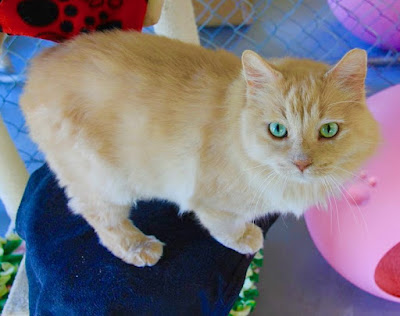Manx Cat Tales with BCR's Bear
Ever run across a kitty with no tail? It's possible that the cat lost its tail due to an accident or injury. However, that cat might also be a manx cat - a cat born with no tail. BCR's handsome Bear is a manx cat. There are lots of stories about how manx cats came to be - from the legend that this cat was late boarding Noah's Ark and lost it's tail when Noah was shutting the doors, to a more science-based theory that they were first bred several hundred years ago on the Isle of Man off the cost of Britain. Manx is one of the oldest breeds of cats has been recognized by the Cat Fanciers Association and the International Cat Association. However, manx is not recognized in the country of its origin - the UK!
Bear is a handsome solid orange kitty but manx cats can also be calico, tabby, or bi-color. Unlike other cat breeds, their heads and ears are usually more rounded. With back legs longer than their front legs, manx cats often have an unusual gait when they walk. They are known for being very friendly, playful, loving and they do fine being the only cat. They are also good hunters, have the potential to gain weight and may need frequent grooming depending on their manx condition.
Manx syndrome is caused by a genetic mutation carried from one generation to another and can mean a cat has no tail, a stumpy tail or a half-length tail. Having a very short or no tail is technically called sacrococcygeal or sacrocaudal dysgenesis, or when the spinal cord doesn't develop properly. While some cats live normal, healthy lives with this condition, there can be some health problems associated with it that can run from mild to severe. According to vethelpdirect.com, one of these potential problems is spina bifida, when the bones along the spine don't fuse as they should and can lead to constipation, hind leg weakness, constipation and even seizures.
Spina bifida can also make possible several other conditions that cause an excess of cerebrospinal fluid on the spine, spinal cord cysts or cavities, anemia caused by bone marrow that doesn't develop correctly, fused vertebrae and malformed back or pelvic bones. Some cats, like Bear, have few problems and may only need some help cleaning up after a box visit! Because manx cats can have a variety of problems, it's important to start regular vet visits right way, whether you adopt a kitten or an older manx cat.
Knowing your cat is a manx, your vet will be able to monitor any changes in his health or physical capabilities and to prescribe medicines to help address them. Based on what the cat is experiencing, treatment might range from pain relief to antibiotics for infections or laxatives for constipation. As always, regular visits to your vet are important so they have a running record of anything your manx cat has developed or experienced. Manx cats can live long and happy lives so monitoring health is really important. Bear says so, too!
CLICK HERE to read more about the manx cat breed.
CLICK HERE to learn more about possible health problems for manx cats.
CLICK HERE to read some unusual things about manx cats.



As a cat lover, I enjoyed your article. However, there are certain points which need fixed, namely, this typo: "the Isle of Man off the cost of Britain..." It should say "coast." Also, the word "Manx" should always be capitalized.
ReplyDelete